By Jack Deth
Given the premise of what film and cinema may look like 40 years hence, I’ll opt for the convenience of handheld devices, flatscreen home entertainment centers and personal 3-D glasses, now that the very first, infant steps of the future Blue Sun Consortium so well-loved in Firefly has put out a bid for the AMC chain of theaters here in the U.S.
Now, as to what cinephiles, movie buffs and assorted hormonally-driven teens will want to view. The sky and its opposite end of the spectrum are the limit. Though Classics will always be present to fall back on. Be it for nostalgia sake. Or just to sit back and experience what good really is and can be. There will always be a healthy clutch of films in dust laden cans ready to be spun up on a projector. Or taken to a lab to be cleaned up, re-mastered and brought back to life in whatever form of medium is in use at the time.
To that end, allow me to prognosticate and put forth three choices for what may be viewed and enjoyed by those of all ages in the future.
Bringing Up Baby (1938)
The definition of screwball comedies of the 20th century stars Cary Grant as David Huxley, a clumsy, mild-mannered paleontologist with Harold Lloyd glasses. Deep in the Sisyphian task of assembling the skeleton of an ancient Brontosaurus, David only needs one bone to complete the task. To add to his stress, David is engaged and soon to be wed to a woman of means whose family can supply extra funding for David’s museum.
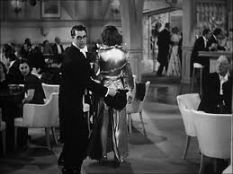
Seeking surcease, David decides to play some golf the next day and meets a striking, fast-talking Katherine Hepburn as Susan Vance, madcap extraordinaire and niece of his future mother-in-law. Susan plays by her own rules and speaks her mind. The repartee between David and Susan is as over-layered, stepped-on, and Hawksian as it is flat-out hilarious! With David constantly trying to catch up when to two meet again at a resplendent, elegant restaurant and night club.
Rapid-fire banter turns into a whispered argument that segues into an accidentally ripped and torn skirt of Susan’s evening gown. Which David tries to cover as best he can with his top hat and quick turns as they seek club’s front door. For a quick trip to Susan’s family’s palatial manse and manicured grounds. Where David is introduced to kith and kin, including a leopard from Brazil named ‘Baby’ and a terrier named ‘George,’ who slyly buried the essential Brontosaurus bone the ‘intercostal clavicle’ somewhere beyond the house while ‘Baby’ ambles away into the night.
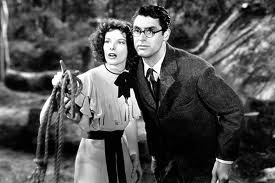
What follows is a primer on comedic timing, quips, pratfalls and stalking through foggy woods and narrow streams. Interspersed with choruses of “I Can’t Give You Anything But Love” which Baby likes, as David and Susan search high and low. Accidentally break windows while seeking assistance. Run afoul of the law and are locked up in the Constabulary’s jail. Where Susan takes on the voice, slang and body language of a gangster’s moll. An incredibly funny few moments that involve a second leopard and mistaken identities. Until a friend of the family arrives and straightens things out.
David goes his way. Susan and Baby go theirs. The intercostal clavicle is recovered and Susan takes it to a now busy David high atop the incomplete Brontosaurus on tall scaffolding to make amends. When Susan sees a nearby flimsy ladder…
Casablanca (1942)
The film that solidified Humphrey Bogart as a romantic leading man still manages to pack a heck of a lot of story and tell it well within its 102 minutes. Wondrously crowded, well designed and executed sets transport to a stylized Morocco, Casablanca, its shadowy casbahs and Rick’s Cafe Americain. The hub of all things curious and worth noting by the Vichy constabulary and its German occupiers.
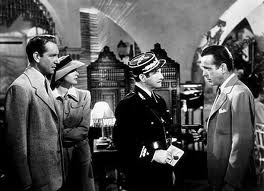
Bogart plays Rick Blaine, expatriate American cafe and casino owner with a fixed roulette wheel that pays on 22. Who drinks alone, plays chess against himself. Has few friends. Is rarely impressed. While exuding an air of supreme clever confidence. Master of his own fate in a corner of the world where suspicion runs rampant and others beg, borrow and steal for exit visas and a way out.
Enter into this world skullduggery, Ilsa Lund. Spectacularly gorgeous Ingrid Bergman. Rick’s old flame from happier times in Paris, just before the Germans rolled in. Unfortunately, Ilsa has brought her husband along. Suave and elegant Victor Laszlo. Leader of the Free French movement and Public Enemy #1 of Conrad Veidt’s Major Heinrich Strasser and his minions. Who would be quite content to keep Ilsa and Victor right where they are.
Who, but director Michael Curtiz and writers Philip and Julian Epstein could wrap a deliciously moody love story around this foundation? As Rick politely reintroduces himself to Ilsa. Sparks flare to life. Aware that she and Victor are in need of a pair of exit visas that Rick possesses. The possibilities are endless as emotions sway. I’ll leave it right there for you to draw your own conclusions.
Goodfellas (1990)
The life of Henry Hill. A Brooklyn kid who says, “As far back as I can remember. I always wanted to be a gangster,” is given the full blown Martin Scorsese treatment. In full blown, lush color. From Henry’s early years hanging out on street corners and parking cars for the meetings of made men he idolized. To huge tips being taken under the wing of slow moving, always cautious ‘Paulie’ Cicero. Henry climbs up the lower tiers of organized crime. Befriending a young young Joe Pesci giving wondrous psychotic life to Tommy DeVito and his friend, Jimmy ‘The Gent’ Conway, played with low-key deliberation by Robert De Niro.
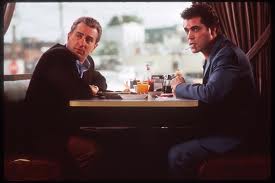
Life is good as Henry dumps school in favor of selling hijacked cigarettes to any and all. Until he is arrested for the first of several times. Surprisingly, the pinch helps rather than hinders Henry’s slow, yet steady climb up the criminal corporate ladder. Henry, now played by a smooth faced, lean Ray Liotta is all style and flash, but not a lot of substance. Part of Jimmy’s crew, Henry learns the ins and outs of the finer points of hijacking semi tractor trailers along the New Jersey Turnpike. When not robbing Idlewild Airport of its employees’ payroll. or burning down restaurants or clubs slowly taken over by Paulie and his friends.
Henry falls in loves with, pursues and courts Karen. A stunning Lorraine Bracco with visits to famed New York nightclubs. Filmed in Steady Cam from the rear entrance. Through the kitchens and to a quickly laid out ringside table in time for Henny Youngman and complimentary champagne. Then taking the time to brutally beat a competitor close to death with a pistol who. Making Karen an accessory after the fact, by giving her the pistol to hide.
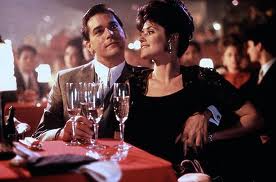
The good life continues. Henry marries Karen. The money rolls in and heists get bigger and bigger. Until one night when a made man runs afoul of Tommy. Is killed messily and buried somewhere Upstate. Then exhumed six months later when Jimmy finds out the land is going to be developed. The wheels start to come off. As Henry takes a mistress and Karen finds out. Threats are made and Paulie tells Henry to get back with Karen. Henry does. Then he and Jimmy go down to Florida to collect some betting markers and draw a delayed bust from the FBI.
Henry discovers drugs behind bars, though life there is better than for most. Against Paulie’s wishes, he continues in the trade as a major heist goes bad. And those involved get very sloppy and spend very conspicuously. Then pay for it rather sloppily to the strains of ‘Layla’ by Derek and the Dominoes. I’ll end it here, lest I get into Spoiler Territory.
Overall consensus
I’ve chosen three films which have stood the test of time. Masterpieces assembled by directors with the clout and ability to get superior writers, cinematographers, set designers. Then turn it all over to superior casts anxious to make their marks. Creating benchmarks that have aged well and improved with time. And will be amongst the first chosen decades from now.
What do you think of Jack’s picks? Are there other films that are already considered classics now and will remain so?

I do love Bringing Up Baby, although I admittedly found it annoying the first time I saw it.
I think I did too actually! It grows on you. Thanks for stopping by 🙂
Yes Yes Yes to all three. Love them all.
Pretty much 🙂
Can’t go wrong with any of these classics, Kevin. Say, did you get a chance to see (and join a few of us here) TCM’s big screen event for the 70th anniversary of ‘Casablanca’ in theaters some weeks back? It was easily one of my highlights for the year (part of the fun being that my wife and kids participated in this, too). Well done, my friend. Thanks for this.
I can definitely testify that watching CASABLANCA on the big screen was a lot of fun 🙂
Hi, Michael:
Everyone needs to see ‘Casablanca’ on the big screen at least once. My turn came back in 1976 at the Odeon Theater in Washington, DC. Then again at the AFI Theater in Silver Springs, MD three years ago. The Odeon was a much nicer, more historic theater.
I’ve been amazed at the number of dry eyes amongst the guys and tears being dabbed away by the girls and women in the lobby afterwards. The true sign of a keeper and classic.
Thanks for the write-up Jack, I appreciate your taking the time to write for the blogathon 🙂 I LOVE all your choices. I can only hope that we can still watch these films 40, 50, even 100 years into the future.
Hi, Paula:
The pleasure was all mine.
Thanks for the opportunity to play around in my comfort zone. I’ve no doubt that these and many others will be around for decades to come.
Can’t go wrong with any of the three Jack 🙂
I absolutely LOVE Bringing Up Baby!
Hi, iluv!
‘Bringing Up Baby’ was my first choice.
Besides being the epitome of a screwball comedy. The dialogue is as hilarious as it is lyrical. Something not fully appreciated until the third or fourth viewing and a Hawks’ signature hallmark. With ‘His Girl Friday’ also close in the running.
Casablanca is already a celebrated classic so that’s a given. I haven’t seen Goodfellas or Bringing Up Baby yet, so I should get on that 🙂 Glad to see you taking part, Jack!
Your assignment for the long weekend is to watch Bringing Up Baby, Ruth LOL Actually if you have TCM, they run it nearly every month.
Were there no choices post-2000 that you think worthy of being a FCM, Kevin? 🙂
I will say though, that if these movies are not considered classics in 2040, it’s only because the entire world went blind and media watching content no longer exists!
Can’t go wrong with these…especially Casablanca for me. Very nice choices!
This is partially my bad, when I sent out the original call for FCM posts, I included current classics that would continue as an option to write, but then decided not pursue that because I wanted people to think about the newest films 🙂
Hi, Terrence:
Thanks so much.
‘Casablanca’ is pretty much universal and shows no signs of losing popularity. The film that put Bogart solidly on the map as a leading man. And gave Jean-Paul Belmondo and other actors a master to emulate in French New Wave years later.
I actually was curious to see if you’d reply with a “No, there aren’t any classics being made anymore…only remakes” kind of a statement. I know that you love classics (as do I) and I was fully anticipating a defense of your choices. 😀
I was ready to embark on a fine conversation of views on the matter.
then I saw Paula’s comment stating that present classics could be included.
However, I don’t blame you on your choices! Fantastic indeed. haha, I just misread into it thinking that you took the stance that classics can’t be made like they used to be. An interesting conversation for sure! 😀
Hi, Terrence:
Excellent points! And I would be remiss if I did not address them. 🙂
I think that there is a huge disparity between the number of films and those that could be considered great or Classic between the 1940s to the 1970s and today. Money and the loss of the ‘Studio’ system, their moguls, stables of contracted actors, directors and writers and number of films made each year have a lot to do with it.
Major corporations now own the studios. Replete with lawyers whose job it is to not offend anyone in the projected audience. When not negotiating percentage of the gross contracts for the agents and actors they represent on the side. Then giving the proposed and completed project one weekend to either make or break at the box office. The whole process nowadays seems a bit ludicrous.
Which is not to say that there are not worthwhile, sometimes even great films coming out of what used to be Hollywood, today. There are. Though those films devote close to a third of their budget to demographics, marketing and often, advanced technologies. I still prefer the old, tried and true method of ‘Throw it against the wall and see what sticks!’ Made popular in the 1940s and 50s. And the “Here’s 10, 000 dollars. Make me a movie!” freedom given young, aspiring directors of the 1970s.
More chances to create ‘product’ equaled more more choices. Sometimes good. Sometimes not. For the audience to decide upon.
Securing my Soap Box.
Carry on.
Love it! ha. a wonderfully thought out response! Thank you sir!
Ni hao Jack
I too think Goodfellas is great, but I think there is an important aspect of the story which is overlooked.
On the surface, and indeed throughout most of the film, the whole thing is a rip roaring tale/biopic about a young man’s rite of passage into the mob. But somewhere in the narrative, and rather subtly, the focus switches across to Jimmy Conway (De Niro) and turns into the story of how one of America’s greatest criminals (tha man who pulls off the Lufthansia heist – forgive spelling) can’t get made in America’s greatest crime organisation because he’s part Irish. His only recourse is to back someone who can (Pesci). Unfortunately, Tommy is too much of a loose cannon and gets whacked. That’s why the destruction-of-the-phone booth scene is so poignant – Conway isn’t crying because they’ve killed his mate; he’s crying because his only chance to be a made member of the mob (admittedly by proxy) has been blown.
For me that’s the essence of Goodfellas … and it was pretty much a stroke of genius on Scorcese’s behalf that he used one of America’s great living actors (DeNiro) to play such a tragic figure in what was essentially a supporting role.
Hi, Mark:
Thanks for adding to the conversation with your salient points.
‘Goodfellas’ is a great little film that’s part bio-pic, part documentary with how the lower tires of organized crime operates (Taking over and burning down clubs that start as a hang out, gets into financial problems, sells out and is burned to the ground. The Lufthansa robbery. Stashing furs in kitchen walk in freezers, etc). Backed up with Jimmy Conway’s tale as Henry’s mentor offset by the Mob’s familial quirks.
De Niro’s Jimmy Conway was a good earner for the Mob and nothing more. Though he should have been. Due to his brains, finesse and style used when filling the Mob’s coffers.
Sorry for the delayed comments here, all of my alerts were going into Spam for some reason…it should be fixed now.